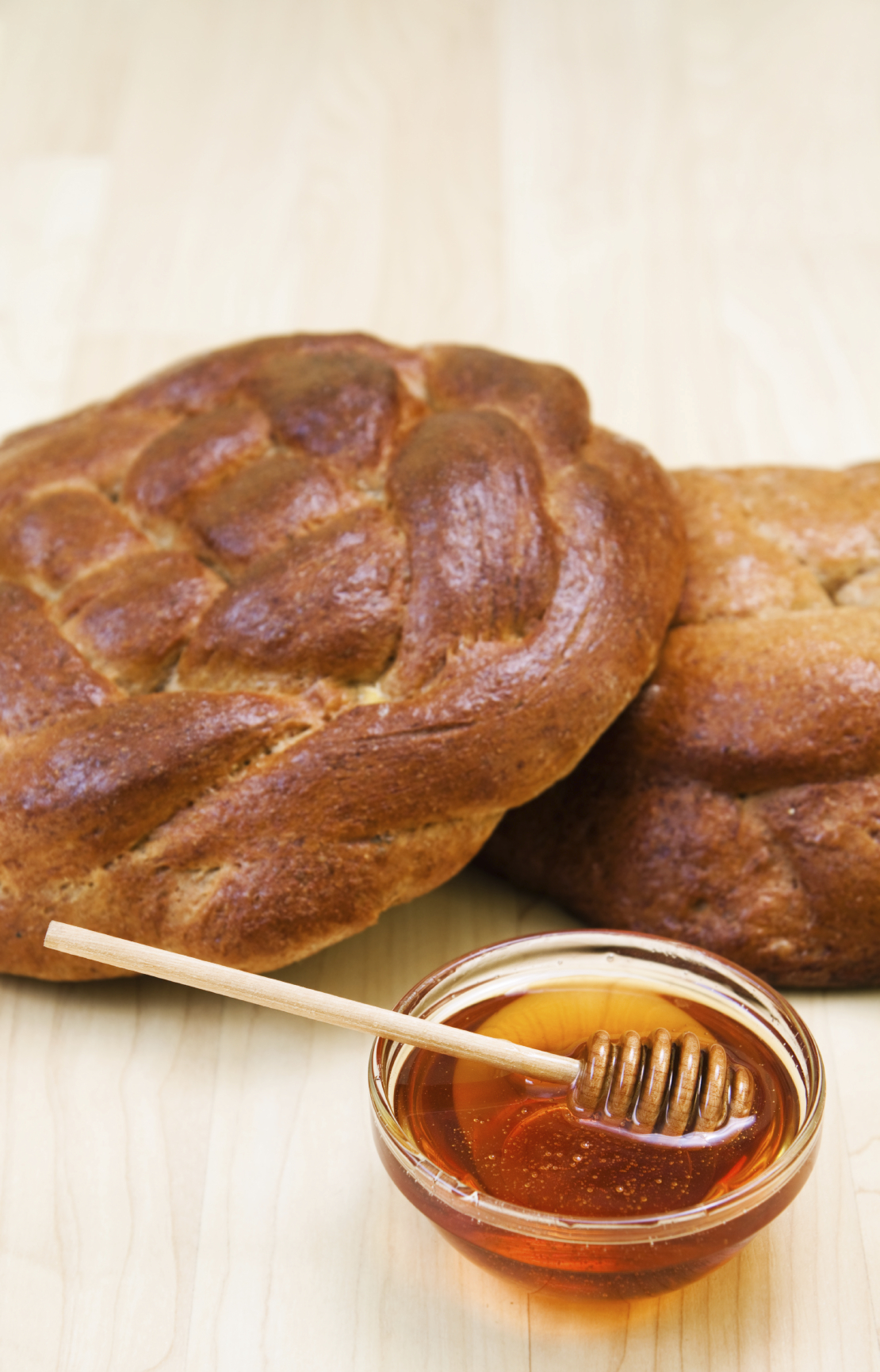Written by Sara Lilkas, Marketing Intern
Rosh Hashanah, which means “Head of the Year” in Hebrew, is the beginning of the Jewish year will be observed September 13th through September 15th. Rosh Hashanah is one of the two High Holy Days in the Jewish religion (the other being Yom Kippur) and there are many traditions and rituals that take place during the holiday. As with every major Jewish holiday, women and girls light candles on each evening of Rosh Hashanah and recite the Jewish blessing Leshanah tovah tikateiv veteichateim, “May you be inscribed and sealed for a good year.” One Rosh Hashanah tradition involving food is to eat apples dipped in honey to represent a sweet New Year and round challah bread to represent the cyclical nature of a year. Raisins or apples are also sometimes added to the challah bread to represent the sweetness of a new year in addition to the apples dipped in honey.
 Different families have different traditions surrounding the holiday that have been passed down throughout the years. After the traditional apples dipped in honey and challah bread are shared there are many different foods prepared for the Rosh Hashanah celebration. Main dishes can vary depending on what your guests enjoy. Some families enjoy chicken dishes, while others may have a more traditional brisket. Side dishes can vary from matzo balls and other traditional foods (Gefilte Fish anyone?), to other dishes that complement your main dish. There’s often roasted vegetables such as carrots and potatoes, but tart foods are generally avoided on this holiday with an emphasis on sweet flavors. As with the apples dipped in honey, sweet flavors are represented throughout the dinner to symbolize the desire for good things in the upcoming year. One of those sweet side dishes you will see featured in most Rosh Hashanah dinners are tzimmes. There are many different variations of this dish, but they are all delicious! If you aren’t sure where to start with your tzimmes here is an easy recipe to follow!
Apples often appear on the dessert menu during the Rosh Hashanah holiday both because of their symbolic significance and because apples often taste sweeter in the fall. There can be everything from apple cakes, pies, or tarts! It ultimately depends on what your family likes to eat. A fun idea is to have people bring different deserts so there is variety, but it also relieves some of the pressure off the host or hostess to prepare a fabulous meal.
For more Rosh Hashanah dinner inspiration check out our Pinterest board! We wish all of our customers observing Rosh Hashanah a Happy New Year!
L’shanah Tovah!
Different families have different traditions surrounding the holiday that have been passed down throughout the years. After the traditional apples dipped in honey and challah bread are shared there are many different foods prepared for the Rosh Hashanah celebration. Main dishes can vary depending on what your guests enjoy. Some families enjoy chicken dishes, while others may have a more traditional brisket. Side dishes can vary from matzo balls and other traditional foods (Gefilte Fish anyone?), to other dishes that complement your main dish. There’s often roasted vegetables such as carrots and potatoes, but tart foods are generally avoided on this holiday with an emphasis on sweet flavors. As with the apples dipped in honey, sweet flavors are represented throughout the dinner to symbolize the desire for good things in the upcoming year. One of those sweet side dishes you will see featured in most Rosh Hashanah dinners are tzimmes. There are many different variations of this dish, but they are all delicious! If you aren’t sure where to start with your tzimmes here is an easy recipe to follow!
Apples often appear on the dessert menu during the Rosh Hashanah holiday both because of their symbolic significance and because apples often taste sweeter in the fall. There can be everything from apple cakes, pies, or tarts! It ultimately depends on what your family likes to eat. A fun idea is to have people bring different deserts so there is variety, but it also relieves some of the pressure off the host or hostess to prepare a fabulous meal.
For more Rosh Hashanah dinner inspiration check out our Pinterest board! We wish all of our customers observing Rosh Hashanah a Happy New Year!
L’shanah Tovah!
 Different families have different traditions surrounding the holiday that have been passed down throughout the years. After the traditional apples dipped in honey and challah bread are shared there are many different foods prepared for the Rosh Hashanah celebration. Main dishes can vary depending on what your guests enjoy. Some families enjoy chicken dishes, while others may have a more traditional brisket. Side dishes can vary from matzo balls and other traditional foods (Gefilte Fish anyone?), to other dishes that complement your main dish. There’s often roasted vegetables such as carrots and potatoes, but tart foods are generally avoided on this holiday with an emphasis on sweet flavors. As with the apples dipped in honey, sweet flavors are represented throughout the dinner to symbolize the desire for good things in the upcoming year. One of those sweet side dishes you will see featured in most Rosh Hashanah dinners are tzimmes. There are many different variations of this dish, but they are all delicious! If you aren’t sure where to start with your tzimmes here is an easy recipe to follow!
Apples often appear on the dessert menu during the Rosh Hashanah holiday both because of their symbolic significance and because apples often taste sweeter in the fall. There can be everything from apple cakes, pies, or tarts! It ultimately depends on what your family likes to eat. A fun idea is to have people bring different deserts so there is variety, but it also relieves some of the pressure off the host or hostess to prepare a fabulous meal.
For more Rosh Hashanah dinner inspiration check out our Pinterest board! We wish all of our customers observing Rosh Hashanah a Happy New Year!
L’shanah Tovah!
Different families have different traditions surrounding the holiday that have been passed down throughout the years. After the traditional apples dipped in honey and challah bread are shared there are many different foods prepared for the Rosh Hashanah celebration. Main dishes can vary depending on what your guests enjoy. Some families enjoy chicken dishes, while others may have a more traditional brisket. Side dishes can vary from matzo balls and other traditional foods (Gefilte Fish anyone?), to other dishes that complement your main dish. There’s often roasted vegetables such as carrots and potatoes, but tart foods are generally avoided on this holiday with an emphasis on sweet flavors. As with the apples dipped in honey, sweet flavors are represented throughout the dinner to symbolize the desire for good things in the upcoming year. One of those sweet side dishes you will see featured in most Rosh Hashanah dinners are tzimmes. There are many different variations of this dish, but they are all delicious! If you aren’t sure where to start with your tzimmes here is an easy recipe to follow!
Apples often appear on the dessert menu during the Rosh Hashanah holiday both because of their symbolic significance and because apples often taste sweeter in the fall. There can be everything from apple cakes, pies, or tarts! It ultimately depends on what your family likes to eat. A fun idea is to have people bring different deserts so there is variety, but it also relieves some of the pressure off the host or hostess to prepare a fabulous meal.
For more Rosh Hashanah dinner inspiration check out our Pinterest board! We wish all of our customers observing Rosh Hashanah a Happy New Year!
L’shanah Tovah! 